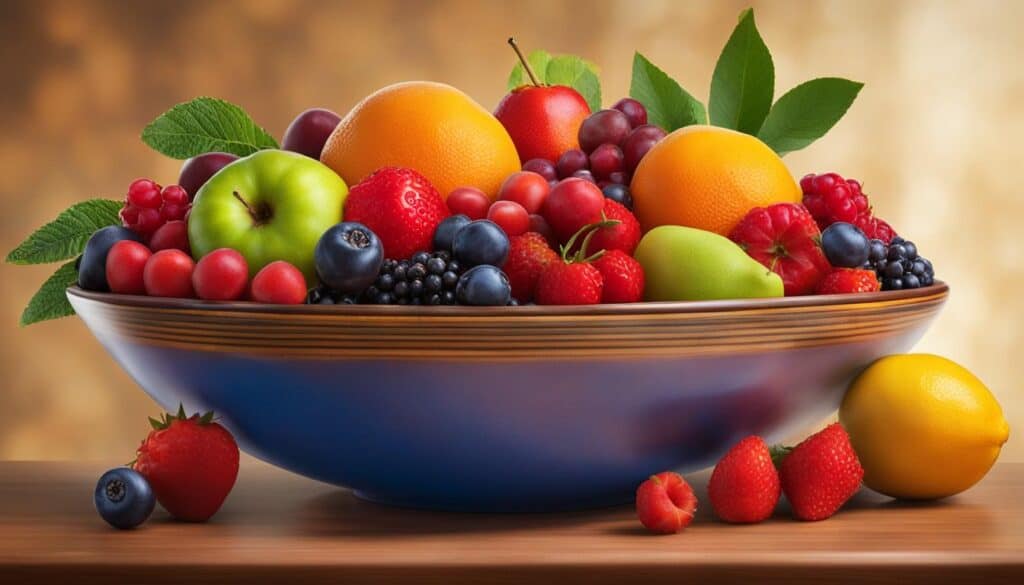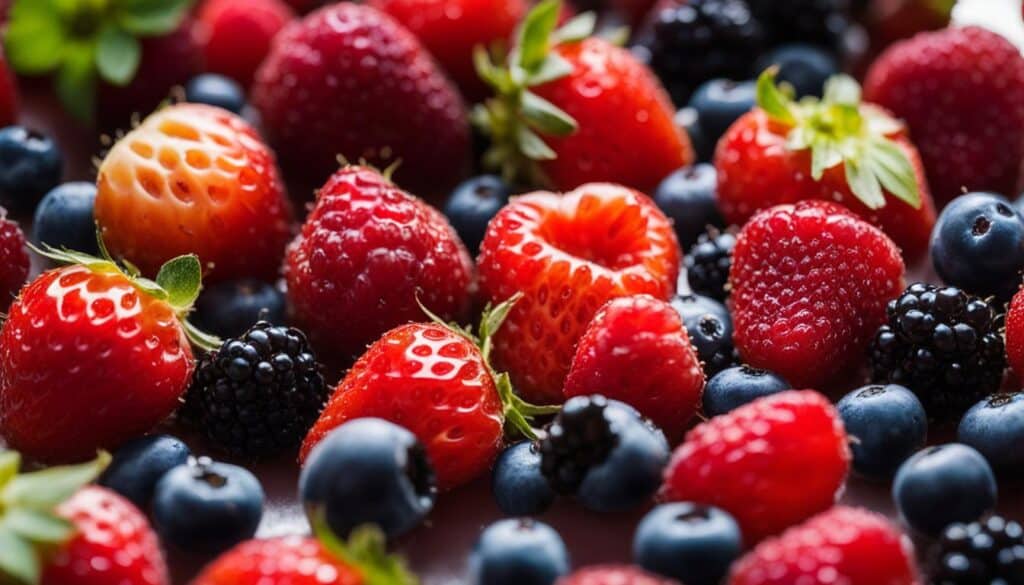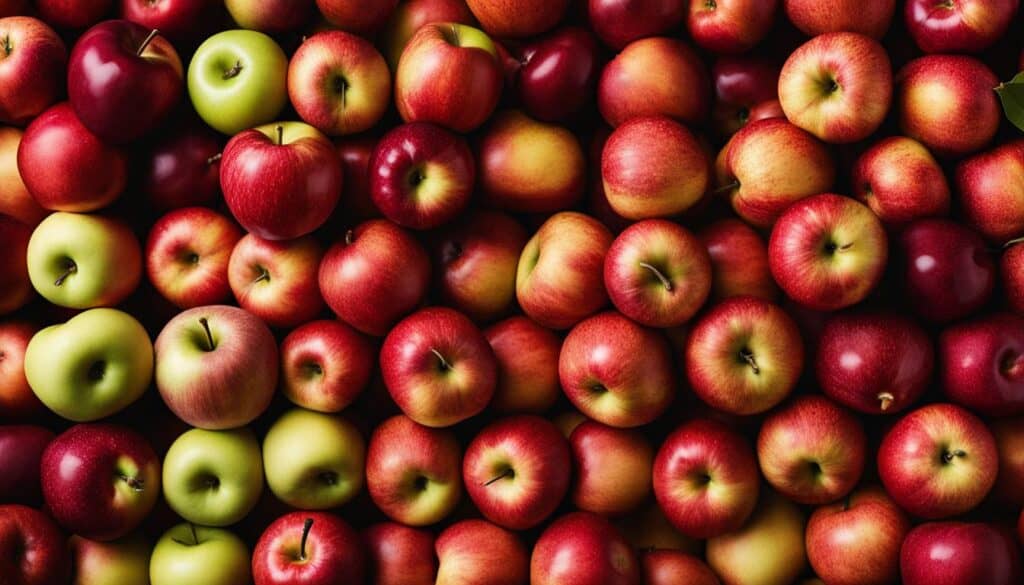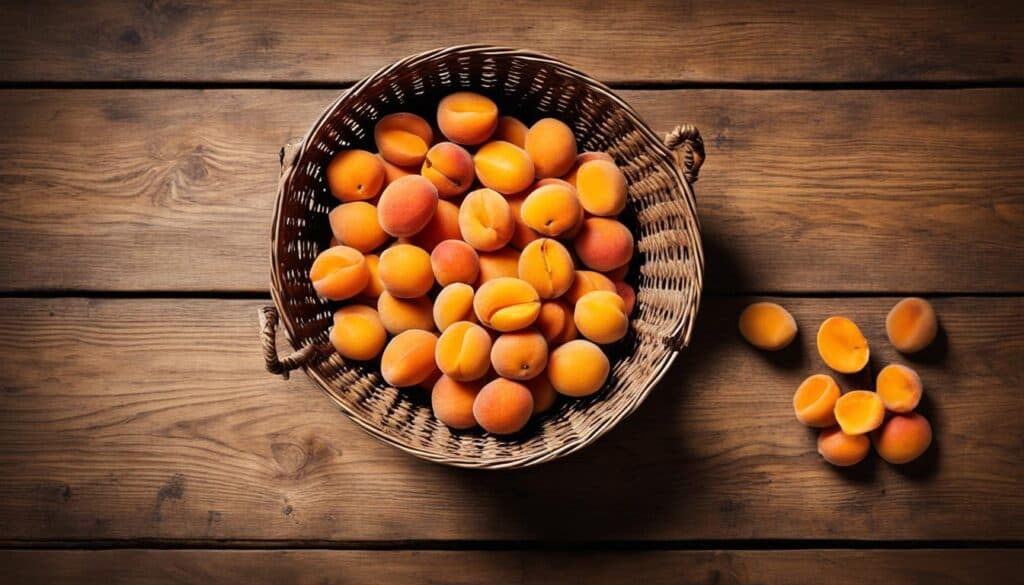Are you curious about the fruit options available at UTA? Look no further! Despite the challenges presented by Utah’s high mountain valleys, UTA offers a diverse range of fresh and delicious fruit choices for its campus community. From strawberries and raspberries to apples and apricots, UTA has something to satisfy every fruit lover’s cravings.
Whether you’re looking for a healthy snack or want to add some vibrant flavors to your meals, UTA has you covered. Let’s explore the types of fruit you can find on campus and discover the variety of options waiting for you.
Key Takeaways:
- Despite the challenging climate, UTA offers a wide variety of fruit options on campus.
- Strawberries, raspberries, apples, and apricots are some of the popular fruit choices available at UTA.
- UTA employs strategies to mitigate the challenges of the high mountain valley climate, ensuring fresh and healthy fruit options.
- Wildlife management techniques are implemented to protect fruit trees and crops in UTA’s gardens.
- Small fruits like strawberries and raspberries thrive in the high mountain valleys and are available at UTA.
The Climate in UTA’s High Mountain Valleys
Utah’s high mountain valleys, where UTA is located, pose unique challenges for fruit production due to their cold winters and short growing seasons. These valleys experience temperatures that can be up to 20 degrees colder during midwinter compared to the surrounding areas. The growing season is less than 120 days, with the last spring freeze occurring from late May to early June and the first fall frost appearing from mid to late September.
Despite these climatic difficulties, UTA has identified fruit varieties that can thrive in this environment, ensuring a fresh fruit selection for campus availability.
Utah’s high mountain valleys, where UTA is located, have very cold winters and short growing seasons of less than 120 days. Midwinter temperatures can be up to 20 degrees colder in the valleys compared to the surrounding areas. The last spring freeze typically occurs in late May to early June, and the first fall frost in mid to late September. Despite these challenges, there are fruit varieties that can thrive in this climate.
One such fruit variety that can withstand the harsh climate is the cold-hardy apple. These apple varieties, such as the mountain rose apple and the Haralson apple, are specifically bred to withstand the colder temperatures and shorter growing seasons of high mountain valleys. Other fruits that can thrive in this climate include raspberries, strawberries, currants, and gooseberries.
Comparison of UTA’s High Mountain Valley Climate with Lower-Elevation Regions
| High Mountain Valleys (UTA) | Lower-Elevation Regions | |
|---|---|---|
| Winter Temperatures | Colder, with temperatures up to 20 degrees below surrounding areas | Milder, closer to average regional temperatures |
| Growing Season | Less than 120 days | Longer, with a higher number of frost-free days |
| Last Spring Freeze | Late May to early June | Earlier, typically in April or early May |
| First Fall Frost | Mid to late September | Later, usually in October or early November |
This comparison highlights the unique climate conditions of UTA’s high mountain valleys, which require specific fruit varieties to thrive. Despite the challenges, UTA is committed to providing a fresh fruit selection that meets the needs and preferences of the campus community.
Fruit Options for UTA’s High Mountain Valleys
Despite the climate limitations, UTA offers a variety of fruit options for its campus community. These include strawberries, raspberries, currants, gooseberries, apples, apricots, and more. The availability of these fruits may vary depending on the season, but UTA strives to provide fresh and nutritious options in its cafeterias and dining facilities. Some popular fruits at UTA include strawberries, apples, and raspberries.
Strawberries are a favorite among students, known for their juicy sweetness and vibrant red color. These delicious berries are packed with antioxidants and vitamin C, making them a healthy and refreshing choice.
Apples are another popular fruit at UTA, offering a variety of flavors and textures. From crisp and tart Granny Smith apples to sweet and juicy Gala apples, there’s an apple variety to suit every taste. Apples are not only delicious but also rich in fiber and essential nutrients.
Raspberries are a crowd-pleaser with their delicate texture and tangy-sweet taste. These berries are high in antioxidants and vitamin C, providing a nutritious and flavorful addition to meals and snacks.
Alongside these popular options, UTA also offers currants and gooseberries, providing unique flavors and nutritional benefits. These small fruits add variety to the campus fruit selection, enriching the overall dining experience.
To give you a better idea of the seasonal availability of these fruit choices at UTA, take a look at the table below:
| Fruit | Season |
|---|---|
| Strawberries | Spring and early summer |
| Raspberries | Summer and early fall |
| Currants | Summer |
| Gooseberries | Late spring to early summer |
| Apples | Fall |
| Apricots | Summer |
These fruit options not only contribute to a balanced diet but also support local agriculture and promote sustainable practices. UTA’s commitment to providing fresh and varied fruit choices reflects its dedication to the well-being of its campus community.
Mitigating Climate Challenges for Fruit Production at UTA

In order to overcome the unique climate challenges present in UTA’s high mountain valleys, we have implemented various strategies to ensure a diverse selection of fresh and healthy fruit options for our campus community.
One of the key practices we employ is season extension. By covering our fruit crops with tarps or frost blankets, we can protect them from late spring and early fall frosts that are common in our region. This helps to extend the growing season and ensure a consistent supply of fresh fruits throughout the year.
Additionally, we utilize unheated greenhouses called high tunnels. These structures create a controlled environment where fruits can thrive despite the cold temperatures. By harnessing the natural sunlight and trapping heat, high tunnels provide an optimal growing environment for our fruit crops.
We also employ frost protection methods such as utilizing heaters near the plants to mitigate the effects of cold temperatures. These heaters help maintain a stable temperature and protect the fruit from frost damage during critical growth periods.
Overall, these strategies enable us to mitigate the challenges posed by the high mountain valley climate, allowing us to offer a wide selection of healthy fruit choices at UTA. Whether you prefer strawberries, raspberries, apples, or other seasonal fruits, you can find an array of options that are both nutritious and delicious.
| Fruit | Season |
|---|---|
| Strawberries | Spring, Summer |
| Raspberries | Summer, Fall |
| Apples | Fall |
| Apricots | Summer |
| Peaches | Summer |
As you can see from the table above, our fruit selection is carefully cultivated to match the seasons and provide you with the freshest options. We take pride in offering a variety of fruits that not only satisfy your taste buds but also nourish your body.
With our efforts to mitigate climate challenges and provide a diverse campus fruit selection, UTA ensures that you can enjoy healthy fruit choices throughout the year. So next time you visit our campus, don’t forget to explore the vibrant selection of fresh fruits available at UTA!
Wildlife Management in UTA’s Gardens

UTA’s gardens provide a lush and vibrant environment for various fruit trees and crops. However, they also attract wildlife such as deer, rabbits, field mice, and ground squirrels, which can pose challenges and potentially damage the fruit trees and crops. To protect our campus fruit selection and ensure abundant fruit options for the UTA community, we have implemented effective wildlife management strategies.
One of the strategies we employ is the installation of woven wire fences to enclose specific areas within the gardens. These fences act as a physical barrier, preventing animals like deer from accessing the fruit trees and crops. By restricting their access, we minimize the risk of wildlife interference and safeguard the popular fruit at UTA.
To further deter deer and protect our fruit trees, we also utilize deer repellent sprays. These sprays contain natural ingredients that emit scents that deer find unpleasant. By applying these sprays strategically, we effectively discourage deer from approaching our fruit trees and impacting our fruit options.
In addition to deer, rabbits, voles, and ground squirrels can also cause damage to fruit trees. To mitigate this risk, we implement exclusion methods using wire fencing or mesh hardware cloth. By installing these protective barriers around the base of the trees, we prevent rabbits, voles, and ground squirrels from gnawing at the bark or digging around the roots, ensuring the well-being of our fruit trees.
At UTA, we prioritize creating an environment where fruit trees and crops can thrive and provide a diverse range of uta fruit options to our campus community. By managing wildlife effectively through the use of fences, repellent sprays, and exclusion methods, we can confidently offer a substantial uta campus fruit selection while maintaining the natural balance of our gardens.
Small Fruits at UTA

When it comes to fruit options at UTA, small fruits take the spotlight. These fruits are not only delicious but also well-suited for the unique high mountain valleys of Utah. Despite the challenging climatic conditions, UTA manages to cultivate a variety of small fruits that thrive in this region. One can find an array of options, including strawberries, raspberries, currants, and gooseberries. These small fruits not only provide a burst of flavors but also offer numerous health benefits.
Strawberries, with their vibrant red color and sweet taste, are a popular choice among students at UTA. They are packed with vitamins and antioxidants, making them a nutritious and refreshing snack. Raspberries, on the other hand, boast a delicate balance of sweetness and tartness, providing a unique flavor profile. They are rich in fiber and vitamin C, promoting overall wellbeing.
In addition to strawberries and raspberries, UTA also offers currants and gooseberries. Currants come in various colors, including red, black, and white, and add a tangy burst of flavor to any dish. They are a good source of vitamin C and antioxidants. Gooseberries, with their tart yet slightly sweet taste, offer a unique flavor experience. They are rich in fiber, vitamins, and minerals, contributing to a healthy diet.
Small fruits at UTA present an excellent opportunity to indulge in these delightful treats while benefiting from their nutritional value. Whether you prefer the sweetness of strawberries, the tanginess of raspberries, or the unique flavors of currants and gooseberries, UTA has you covered.
| Fruit | Description | Nutritional Benefits |
|---|---|---|
| Strawberries | Sweet and vibrant red fruit | Rich in vitamin C and antioxidants, a good source of dietary fiber |
| Raspberries | Tangy and flavorful berries | High in fiber and vitamin C, contribute to a healthy immune system |
| Currants | Tangy berries in various colors | Good source of vitamin C and antioxidants |
| Gooseberries | Tart and slightly sweet berries | Rich in fiber, vitamins, and minerals |
Apple Varieties at UTA

Apples are a popular fruit option at UTA, and several varieties thrive in the high mountain valleys of Utah. These apples provide a range of flavors and can be enjoyed fresh or used in various culinary preparations.
“Apples are nature’s perfect snack.”
– Unknown
At UTA, you’ll find a diverse selection of apple varieties, each with its own unique taste and texture. Here are some of the popular apple varieties available:
- Gala
- Granny Smith
- McIntosh
- Golden Delicious
- Red Delicious
Whether you prefer a sweet and crisp flavor or a tart and tangy taste, there’s an apple variety for everyone’s palate. These apples are sourced from local orchards, ensuring freshness and quality.
Enjoy them as a healthy snack between classes, add them to your salads for an extra burst of flavor, or incorporate them into your favorite dessert recipes.
Apple Variety Comparison
Let’s take a closer look at the characteristics of these apple varieties:
| Variety | Taste | Texture | Best Use |
|---|---|---|---|
| Gala | Sweet and mildly tart | Crisp | Snacking, salads, baking |
| Granny Smith | Tart and tangy | Firm | Snacking, pies, sauces |
| McIntosh | Sweet and tangy | Tender | Snacking, applesauce |
| Golden Delicious | Sweet and mildly tart | Crunchy | Snacking, salads, baking |
| Red Delicious | Sweet | Soft | Snacking, salads |
Next time you’re in the UTA cafeteria or dining facility, be sure to grab an apple and enjoy the delicious flavors that these varieties have to offer. They are a popular choice among students and staff alike, and their availability may vary depending on the season.
Apricot and Other Stone Fruits at UTA

At UTA, you’ll find more than just apples. Our campus offers a delightful array of apricots and other stone fruits that will satisfy your cravings for sweet and juicy flavors. Indulge in the tantalizing taste of Harcot and Tilton apricot varieties, renowned for their rich flavor profiles. These apricots are bursting with sweetness and are a popular choice among fruit enthusiasts. But the options don’t stop there! UTA also provides an assortment of other stone fruits, including peaches, plums, and cherries, offering a diverse selection of flavors and textures for the campus community.
Whether you’re in the mood for a refreshing peach or a succulent cherry, you’ll find a healthy fruit choice at UTA to suit your preferences. These stone fruits not only offer a delightful eating experience but also provide essential nutrients that promote overall well-being. Treat yourself to the delectable flavors and nutritional benefits of apricots and other stone fruits available at UTA.
To give you a glimpse of the variety of stone fruits found at UTA, here’s a comparison:
| Fruit | Taste | Texture | Nutritional Benefits |
|---|---|---|---|
| Apricots | Sweet and juicy | Soft and velvety | High in vitamin A and C, good source of fiber |
| Peaches | Sweet and tangy | Juicy and velvety | Rich in vitamins C and A, good source of potassium |
| Plums | Sweet and slightly tart | Firm and smooth | Good source of vitamins C and K, high in antioxidants |
| Cherries | Sweet and tart | Crunchy and juicy | High in antioxidants, good source of fiber |
Indulge in the diverse flavors and textures of UTA’s stone fruits. Whether you prefer the soft and velvety apricots, the juicy and smooth peaches, the firm and tangy plums, or the crunchy and refreshing cherries, UTA has the perfect selection of stone fruits to satisfy your taste buds.
Conclusion
At UTA, we understand the importance of providing our campus community with fresh and nutritious fruit options, despite the challenges of our high mountain valleys. That’s why we offer a diverse selection of fruits that thrive in our unique climate.
From small fruits like strawberries and raspberries to popular choices like apples and apricots, there is something for everyone at UTA. Whether you’re looking for a refreshing snack or a burst of flavor, our fruit options will satisfy your cravings.
What sets us apart is our commitment to seasonality. We strive to provide seasonal fruit options, ensuring that you not only enjoy the freshest produce but also support local agriculture. So, come and explore the vibrant selection of fresh fruit at UTA, and boost your nutrition with the taste of our high mountain valleys today.
FAQ
What types of fruit does UTA have?
UTA offers a variety of fruit options, including strawberries, raspberries, currants, gooseberries, apples, apricots, and more.
Are there fresh fruit options available at UTA?
Yes, UTA strives to provide fresh and nutritious fruit options in its cafeterias and dining facilities.
What are the popular fruit choices at UTA?
Some popular fruits at UTA include strawberries, apples, and raspberries.
Are there seasonal fruit options at UTA?
Yes, the availability of fruit options at UTA may vary depending on the season.
How does UTA overcome the climate challenges for fruit production?
UTA implements strategies such as season extension practices, covering fruits with tarps or frost blankets, utilizing unheated greenhouses called high tunnels, and employing frost protection methods.
How does UTA manage wildlife in its gardens?
UTA uses strategies such as enclosing areas with woven wire fences, applying deer repellent sprays, and using wire fencing or mesh hardware cloth to protect trees from rabbits, voles, and ground squirrels.
What types of small fruits are available at UTA?
UTA offers small fruits such as strawberries, raspberries, currants, and gooseberries.
What varieties of apples are available at UTA?
UTA may offer varieties such as Gala, Granny Smith, McIntosh, Golden Delicious, and Red Delicious apples.
What stone fruits are available at UTA?
UTA may offer stone fruits such as apricots, peaches, plums, and cherries.





Leave a Reply